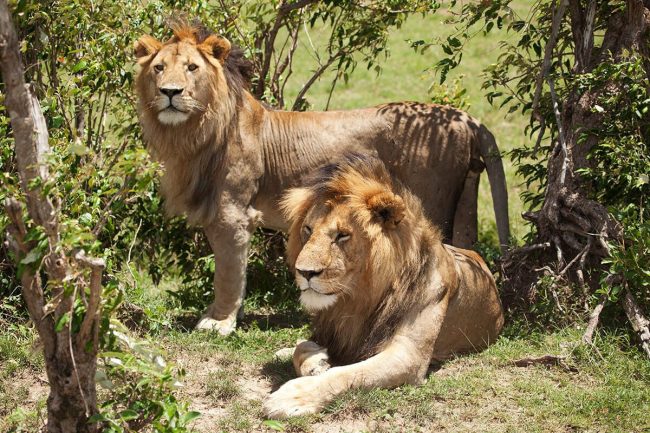Tanzania has over 16,000 lions thus positioning the country as the best destination for wildlife enthusiasts who are eager to see these big cats in their natural homes. With Monteero Safaris, you can have the finest tour experience of these vulnerable big cats in the following protected areas,
Lake Manyara National Park
Lake Manyara National Park in the Manyara region in the northern part of Tanzania is over 325 square kilometers in size. The park sits between the Great Rift Valley and Lake Manyara, the soda lake known for its population of flamingos. Tree-climbing lions are the main attractions for visitors in this site which is part of the northern safari circuit in Tanzania. Besides these unique lions, visitors can enjoy birding, game drives, hot air ballooning, cultural encounters and nature walks. The vast savannah grasslands and woodlands, and forest are lovely scenes that enhance the lion safari experience. Lake Manyara National Park is about 109 kilometers from Arusha and the road trip eastwards takes 1.5 to 2 hours.
Ngorongoro Conservation Area
Explore the lions in Ngorongoro Conservation Area during your northern safari circuit in Tanzania. Ngorongoro is a renowned UNESCO World Heritage site that spans around 8,292 square kilometers in northern Tanzania. The ecosystem is composed of a variety of habitats, ranging from savannah grasslands, woodlands, swamps etc. making Ngorongoro Conservation Area rich in biodiversity. The destination is also the home of the world’s largest volcanic caldera called the Ngorongoro crater and the seasonal Lake Magadi. Other tourist activities here include birding, hot air ballooning, guided nature walks and cultural tours. Ngorongoro Conservation Area is about 180 kilometers from Arusha Airport and the road trip takes around 2.5-3 hours.
Serengeti National Park
Serengeti National Park in the northern part of Tanzania spans around 14,763 square kilometers in size. This UNESCO World Heritage Site is home to over 200 lions that can be found in its vast savannah grasslands and woodlands. Serengeti National Park is part of the greater Mara-Serengeti landscape which is renowned for the Great Migration. During this annual event, a tour to see lions hunting the wildebeest, zebras and gazelles makes the experience worthwhile. Other tourist activities include birdwatching, hot air ballooning, cultural tours, and nature walks. The distance of Serengeti National Park from Arusha Airport is about 230 kilometers on road, which takes 4.5 to 5 hours on a safari car.
Tarangire National Park
Tarangire National Park in the northern part of Tanzania spans around 2,850 square kilometers and has over 155 individual lions that can be encountered by visitors. The park is renowned for its rare baobab trees and large herds of elephants. Visitors on a safari to see lions will have a fun time especially during the dry season when a variety of mammals gather around the Tarangire river to drink from this primary water source. Tarangire National Park is about 104 kilometers from Arusha Airport and the road trip takes almost 2 hours on a comfortable safari car by Monteero Safaris. Besides a tour to see lions and witnessing the Great Migration, other activities include nature walks, photography, birding, hot air ballooning, and bush breakfast.
Ruaha National Park
Ruaha National Park in the central part of Tanzania is the largest park in the country with an estimated size of around 20,226 square kilometers. It gets its name from the great Ruaha river flowing along its southeastern margin, making this site a hotspot for wild animals including the lions. Records show that over 286 lions are found in this ecosystem, therefore an exciting place to visit in order to observe these big cats in their natural habitat. Besides lions, Ruaha National Park is known for its large numbers of elephants that reach approximate 16,000.
Best time to see lions in Tanzania
Seeing lions in their natural homes in Tanzania is done throughout the year. But for maximum visibility, especially if you are eager to witness them in action in their predator-prey dynamic with the angulates, visit during the dry season. During the season, the weather is generally warm and dry to create less dense vegetation cover and relatively fewer water sources. These are perfect conditions to increase visibility of the lions as well as spot their prey, that mostly gather around the fewer water resources. The dry season generally occurs during the months of June to September and December to February.
The tracks are also navigable during the dry season since they are drier in comparison to the rainy season. However, the dry season, which often coincides with the peak season forces you to book the best accommodation in advance, and Monteero Safaris will help you with this. In the rainy season, the tracks are wet and muddy thus affecting your movement, therefore good for daring wildlife enthusiasts. The rainy season falls in the months of March to May and from October to November and brings a lot of rainfall that causes dense vegetation. This enhances photography since lions are photographed against a green background.
What to pack
A safari in Tanzania to see lions in their natural homes is much more enjoyable if you ensure to pack the following items or gear,
- A pair of comfortable walking shoes
- Insect repellent
- Wide-brimmed hat
- Lightweight clothes made of dull colored fabric
- Refillable water bottle
- Snack box with energy snacks
- UV protection sunglasses and UV protection suncream
- Backpack
- Camera and extra batteries
- A pair of binoculars
- Basic first aid kit
- Extra cash
- Warm sweater
- Light rain jacket

